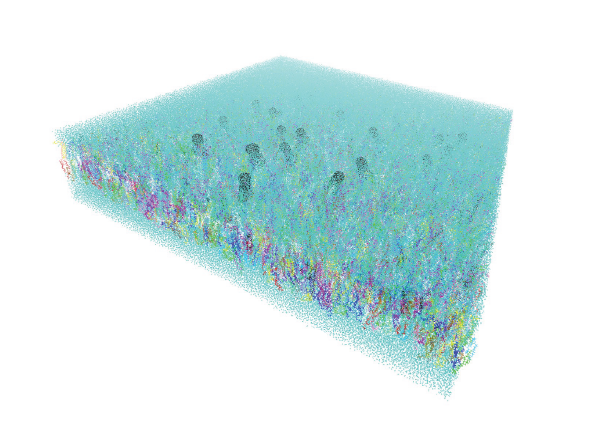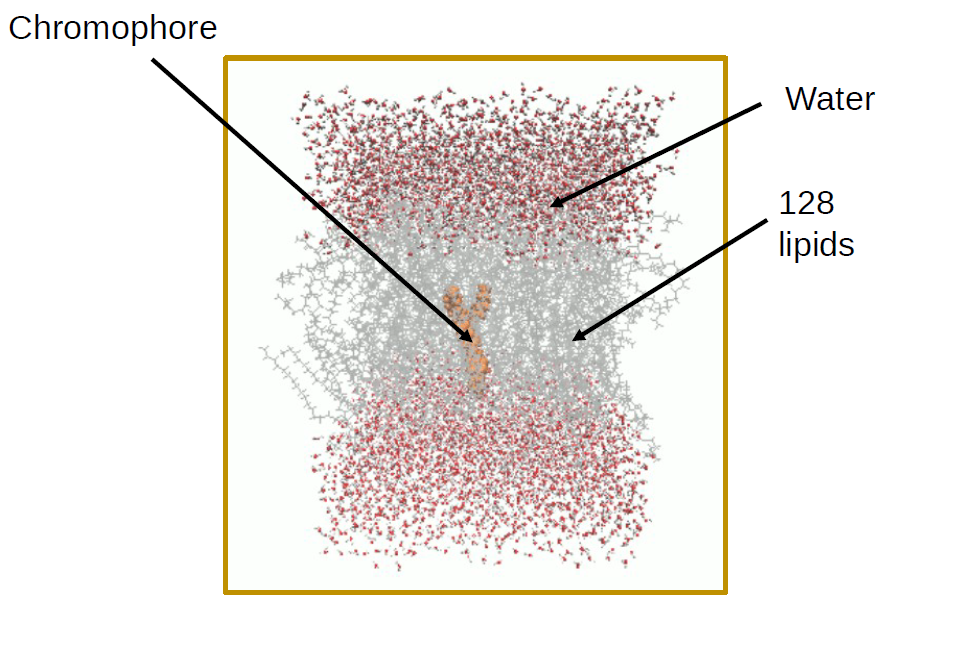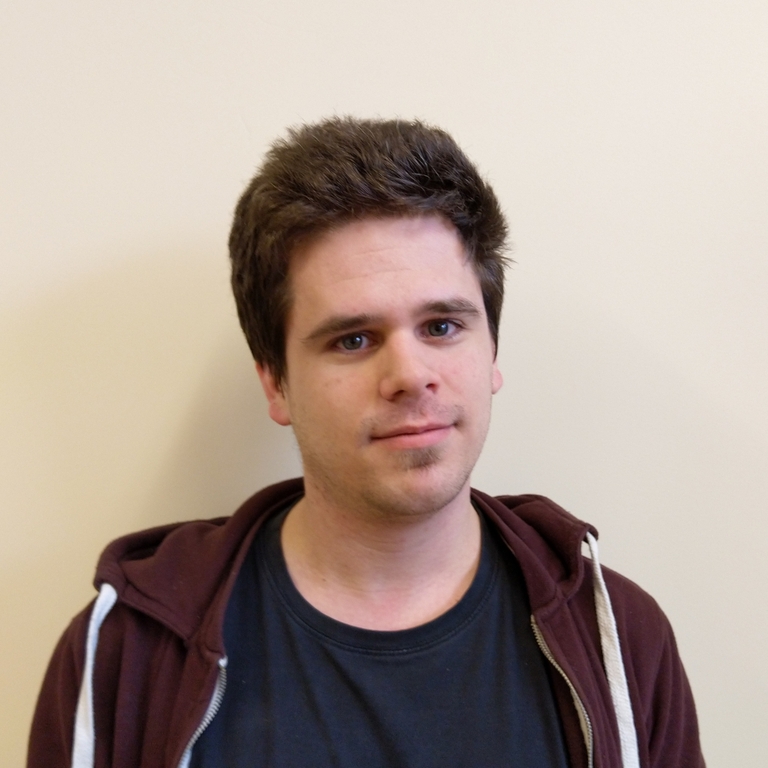User Story: Towards better disease detection using multi-million atom simulations

Published on 30/04/2024
Diseases have different biological signatures whose detection can lead to an early diagnosis. For example, some diseases such as Alzheimer's, Parkinson's, and type-2 diabetes are linked to modification of the human cell membrane composition. New ways of detecting these changes could help doctors monitor patients.
Cell membranes, the walls that separate the inside of the cell from the outside, are highly complex and heterogeneous structures containing many kinds of lipids and proteins, and their behaviour is not yet fully understood. To detect the signature of a specific disease on a membrane, exogenous chromophores can serve as a probe. These molecules interact with light, and interestingly, this interaction is affected by their surroundings, allowing their close environment to be revealed using lasers. A team led by Pr. Benoît Champagne from the University of Namur wanted to explore further than ever before the influence of the composition of the membrane on this molecular probe.
Modeling a realistic cell membrane
Two researchers in the Theoretical Chemistry lab of the University of Namur, Dr. Pierre Beaujean and Dr. Charlotte Bouquiaux (UNamur) together with their supervisor, Pr. Champagne, have recently published a paper in which they have studied the cell membrane, using computational chemistry methods, to obtain information from the optical response of a chromophore, the di-8-ANEPPS, depending on the structure of the membrane.
Dr. Charlotte Bouquiaux : “We are investigating very large systems for which we need a detailed atomistic view that is unreachable with experiments. Therefore, computer simulations are needed to obtain an accurate model of the morphology of a membrane.”

Model of the membrane containing a chromophore
A realistic representation of a cell membrane requires an atomistic model, i.e. each atom constituting the molecules (lipids, proteins, chromophores, and water) must be represented. As many different lipids are present in a membrane, millions of atoms are needed to obtain a representative membrane composition. Until recently, it was impossible to study such massive systems.
Dr. Pierre Beaujean : “Thanks to (pre-)exascale supercomputers, multimillions atom systems can be investigated. Our system contains about 3 million atoms, including nearly 50 kinds of lipids and 20 probe molecules.”
To perform their simulation, Dr. Pierre Beaujean and Dr. Charlotte Bouquiaux used molecular dynamics (MD), a method that simulates the movement of molecules as a system evolves over time. With MD, they simulated the evolution of the cell membrane during a period of around 300 nanoseconds, which took more than a hundred million steps and required more than 10 million CPU.hours. They obtained different membrane geometries, allowing them to highlight a curvature fluctuation.

A section of the membrane containing 50 kinds of lipids after the simulations
Dr. Pierre Beaujean : “We also found a difference in the distribution of the lipids near the chromophore, in particular, there is a low concentration of cholesterol around the chromophore.”
Simulating the optical spectroscopy
Using the results of the MD calculations, they investigated the optical response of the chromophores using a quantum chemistry code. The spectroscopy that is used to determine the optical response of the chromophores is based on an optical process called second harmonic generation (SHG).
Dr. Charlotte Bouquiaux : “SHG is a nonlinear optical phenomenon, which means that the outgoing response of the system does not depend linearly on the intensity of the incoming light due to its interactions with some molecules (here, mainly the chromophores).”
In SHG, two photons of the same energy (and therefore of the same colour and wavelength, for example, a red light at a wavelength of 700 nm) combine into a single photon with twice the energy (blue light at a wavelength of 350 nm). This spectroscopy is highly sensitive to the molecular environment of the active probes and has the advantage of using low-energy photons, limiting the damage to the cell tissue.
An enormous amount of data to analyze
Once the optical response of the chromophores has been simulated, the results have to be interpreted. However, due to the large number of geometries, the amount of data collected was enormous. Appropriate machine learning tools were then used to determine the correlation between features like the lipid composition near the chromophore or the orientation of the chromophore and its SHG response.
Dr. Pierre Beaujean : “This data analysis helped us to understand better how to determine the morphology of the membrane based on the SHG response.”
As the model of their study represented a healthy tissue, further research will be necessary to determine the morphology and the SHG response of membranes having compositions characteristic of a particular disease. Nevertheless, this study is a promising demonstration of the potential of such multi-million atoms simulation for biomedical applications.
A diversity of HPC solutions needed
This comprehensive study required three stages of calculations, each with specific resource requirements. The MD simulations were the most demanding due to the large number of atoms and steps and a Tier-0 supercomputer was necessary.
Dr. Pierre Beaujean : “After a benchmark on Lucia, the Tier-1 supercomputer of the Walloon Region, we applied for a call for the Belgian share of the LUMI supercomputer, which was granted. We used 4480 cores distributed on 35 nodes, allowing us to perform 10 million steps per day.”
On the other hand, the SHG calculations and the data analysis demand less computing power and were performed on different Tier-2 supercomputers of the CÉCI. This shows the complementarity of the different levels of supercomputing in Belgium and Europe.
Related publication: Charlotte Bouquiaux, Benoît Champagne, and Pierre Beaujean, Multimillion Atom Simulations of Di-8-ANEPPS Chromophores Embedded in a Model Plasma Membrane: Toward the Investigation of Realistic Dyed Cell Membranes, Journal of Chemical Information and Modeling 2024 64 (2), 518-531 (DOI : 10.1021/acs.jcim.3c01568 ).
Charlotte Bouquiaux
Charlotte obtained both her bachelor's and master's degrees in chemistry from the University of Namur. She then continued her training with a PhD in the theoretical chemistry group of Benoît Champagne. She has recently taken up a new postdoctoral position in the group of Rebecca Notman at the University of Warwick (UK).
Pierre Beaujean

Pierre also obtained his PhD in theoretical chemistry group of Benoît Champagne (University of Namur) in 2021. After one year in both the User Training and Raising Awareness work packages for the EuroCC project, he went back to quantum chemistry and he currently is a postdoctoral researcher in the ECOBAT project to develop the batteries of tomorrow.